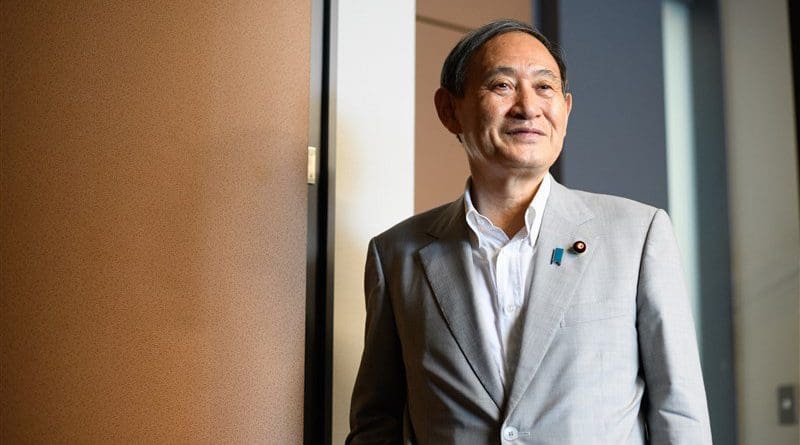A Change Of Leadership In Japan – Analysis
By IPCS
By Dr Sandip Kumar Mishra*
On 3 September 2021, Japanese Prime Minister Yoshihide Suga announced that he would not contest his party’s leadership position and that his term would end on 29 September 2021. This announcement comes nearly a year into Suga’s assumption of office in mid-September 2020. Suga cited health as the reason behind his decision to step down. However, it is believed that the decision was taken in the face of falling popularity ratings, and in order to give the Liberal Democratic Party (LDP) a better chance in the upcoming general elections. The LDP will elect a new leader and the prime minister of Japan by 29 September.
For many observers, it is strange that Suga, who started with a popularity rating of more than 74 per cent just a year ago, has been unable to sustain it, and the rating has now gone down to less than 30 per cent. As the right hand man of former Prime Minister Shinzo Abe, and his cabinet secretary, Suga was considered to be a leader with enough experience to maintain policy continuity in Japan. In the initial phase of his tenure, therefore, he tried to reach out to international leaders to assure them of the continuity of Japanese foreign policy. With regard to domestic politics, he lowered mobile phone rates, began insurance for fertility treatment and continued the TOGO programme. But soon, Suga was receiving criticism for removing scholars from a government advisory panel just because the scholars did not agree with the government’s position. In December 2020, he decided to raise the healthcare costs of citizens over 75 years of age, claiming that it would “curb the growing burden on working generations.”
The COVID-19 pandemic and Japan’s poor economic performance can be cited as other reasons for Suga’s stepping down. Even though he tried to improve his image by successfully organising the Summer Olympics in Tokyo, it was probably not enough. There are also allegations that because of the Olympics, Japan witnessed a surge in COVID cases across the country. While announcing his intent to step down, Suga stated that for the remainder of his time in office, he would like to concentrate on dealing with the pandemic.
Even as late as August this year, Suga appeared to be fighting to keep his position, when he indicated that he would be sacking his long-term ally, Nikai Toshihiro, from the position of the party’s secretary general. He also appeared to be considering the possibility of a snap election, which he later abandoned. One of Suga’s last attempts to salvage the leadership debacle within the LDP was to consider a reshuffle of the party executives as well as his cabinet. However, he soon realised that it would not be possible to sustain his position and thus finally decided to quit. His exit is also related to the LDP’s prospects in the general elections for the House of Representatives, which will take place on or before 28 November 2021.
On 17 September 2021, the process with which to elect a new leader in the LDP officially began, with four candidates in the fray: Taro Kono (58), minister for Administrative Reform; Fumio Kishida (64), the former minister for Foreign Affairs of Japan; Sanae Takaichi (60), the former minister of Internal Affairs and Communications; and Seiko Noda (61), the acting secretary-general of the LDP. While Kono and Takaichi appear to be popular candidates, Takaichi has the support of former Prime Minister Shinzo Abe. Additionally, her conservative positions, both in foreign policy as well as economic orientation, may give her the political upper hand. As for Kono, he has been talking about a new orientation in ‘Abenomics’ as well, along with a focus on shifting the political tides within the party, which he sums up as “change the LDP and change the politics.” It would be interesting to see if he is able to move ahead, in spite of apparently looking like a rebel within the party.
Kishida has argued for an increased pandemic stimulus package as well as “incoming doubling plan” which may tackle income disparities and make him popular with the middle-class, though it is doubtful as to whether this would give him an edge in the leadership race. Noda, on the other hand advocates for several progressive reforms for women, LGBTQ, and renewable energy, but she is not considered to be a heavyweight in the LDP.
Irrespective of who the next prime minister of Japan will be, the biggest challenge for any leader will be the upcoming general elections. As 2021 comes to an end, the elections for the new Japanese prime minister, as well as the general elections to the Lower House will both be vital for the future course of Japan’s foreign and domestic policy. It would be interesting to see, for instance, how the absence of a charismatic leader like Shinzo Abe affects the LDP internally, besides impacting its place in Japanese politics. There are also apprehensions that Japanese politics might slip yet again into another phase of frequent leadership changes. In his day, Shinzo Abe provided political stability, but in the absence of such charismatic leadership, old patterns in Japanese politics might repeat themselves.
*Dr Sandip Kumar Mishra is Associate Professor, Centre for East Asian Studies, SIS, JNU, & Distinguished Fellow, IPCS.

